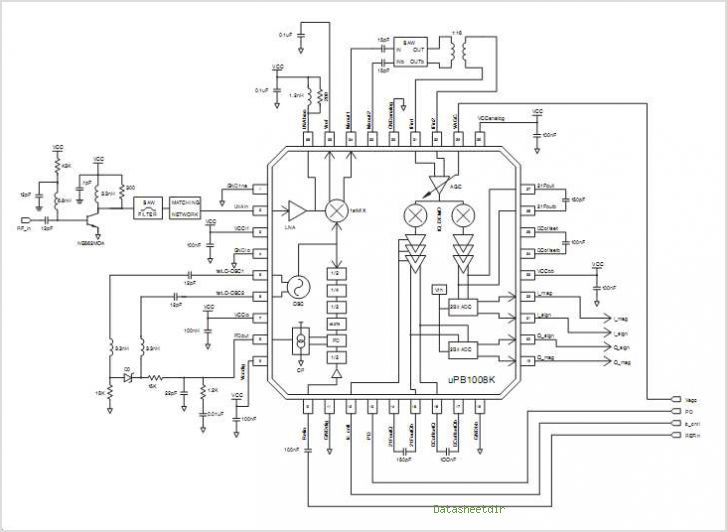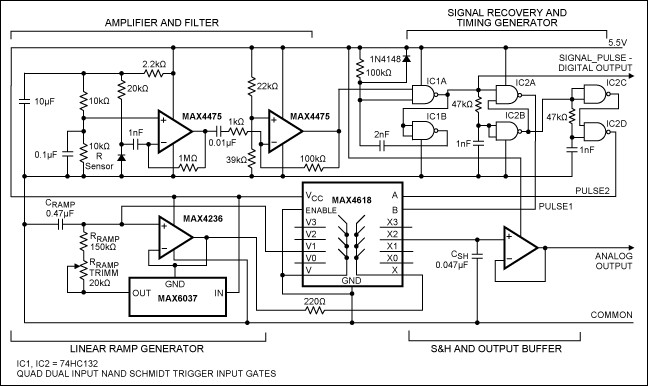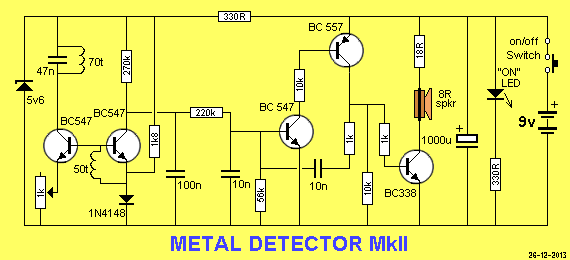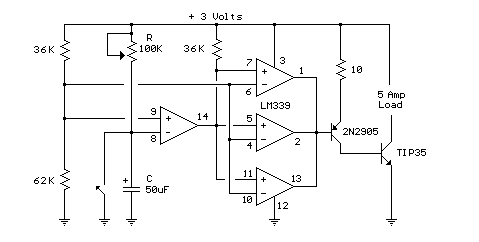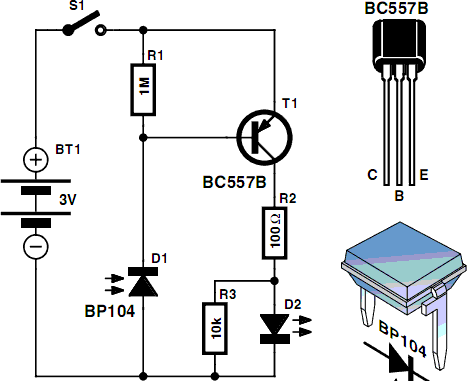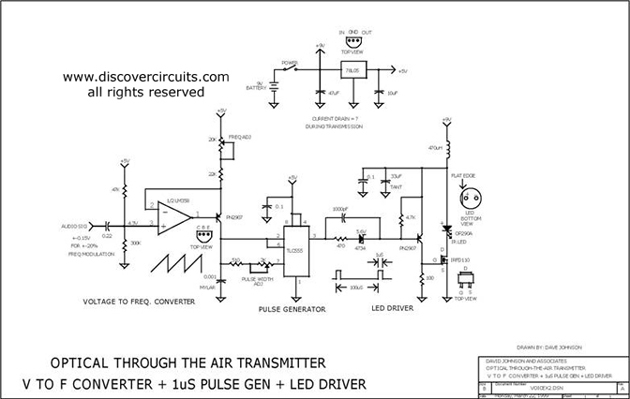
Low voltage detector
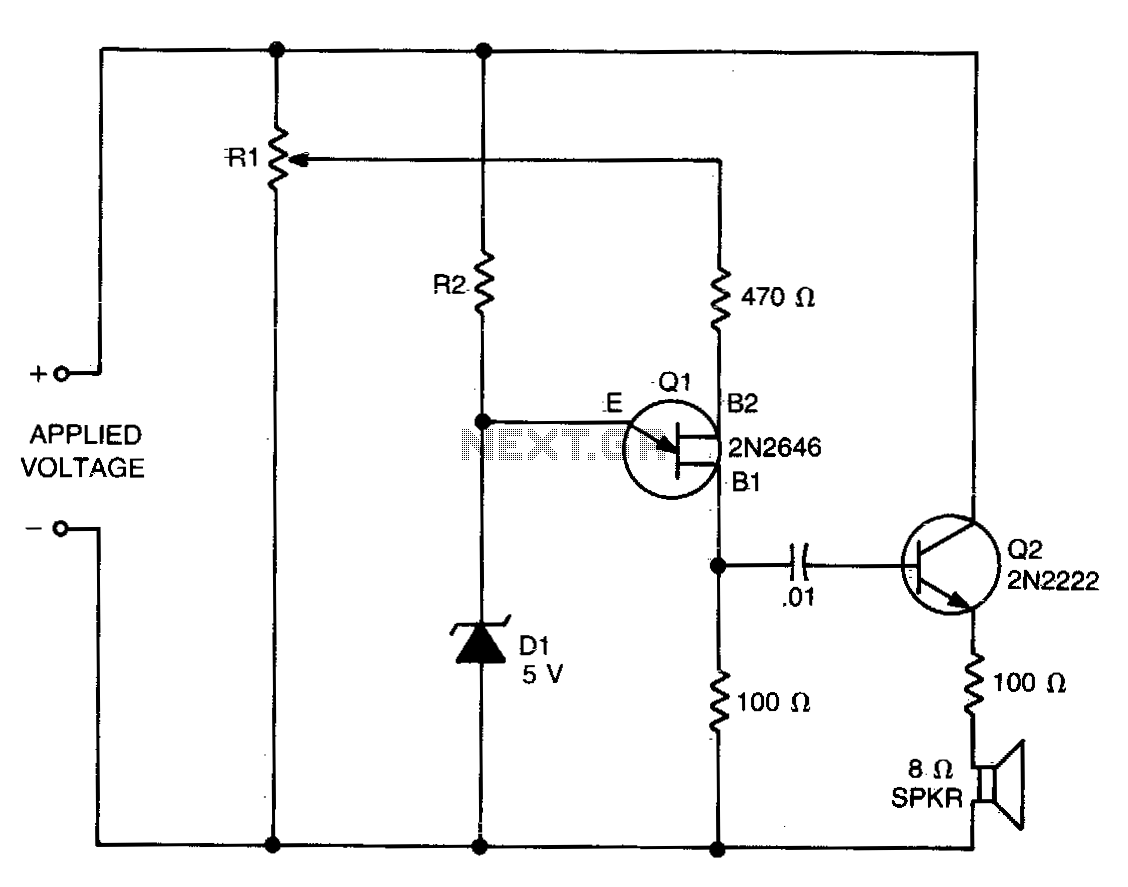
The values of R1, R2, and D1 are selected based on the voltage applied. Using a 12-volt battery, R1 is set to 10 kΩ, R2 to 5 kΩ, and D1 is a 5-volt zener diode or a string of forward-biased silicon rectifiers totaling approximately 5 volts. Transistor Q1 is a general-purpose Unijunction Transistor (UJT), while Q2 is any small-signal or switching NPN transistor. When the detector is connected across the battery terminals, it draws minimal current and does not interfere with other devices powered by the battery. If the voltage drops below the trip voltage set by R1, the speaker emits a warning beep. The frequency of the beeps is determined by the degree of undervoltage. If additional voltages are monitored, R1 should be chosen to draw only 1 mA or 2 mA. The zener diode D1 is approximately half of the desired trip voltage, and R2 is selected to bias it at about 1 mA.
The circuit operates as a voltage monitoring system that utilizes a combination of resistors, a zener diode, and transistors to provide an alert when the voltage level of a battery drops below a predefined threshold. The configuration begins with a 12-volt battery supplying the circuit. Resistor R1, valued at 10 kΩ, acts as a voltage divider, setting the reference voltage for the detection mechanism. Resistor R2, at 5 kΩ, provides the necessary biasing for the zener diode D1, which regulates the voltage to approximately 5 volts. This zener diode may be replaced by a series of forward-biased silicon rectifiers that also yield a similar voltage drop.
Transistor Q1, a Unijunction Transistor, is pivotal in the detection process, triggering the alert mechanism when the voltage falls below the threshold established by R1. The second transistor, Q2, serves as a small-signal or switching NPN transistor, which amplifies the signal from Q1 to activate the speaker. The speaker generates beeps as a warning signal that corresponds to the level of undervoltage detected. The frequency of the beeping is directly proportional to the amount of voltage drop, providing a clear indication of the battery's status.
The circuit is designed to draw minimal current when the detector is connected, ensuring that it does not adversely affect the operation of other devices powered by the same battery. In scenarios where multiple voltages are monitored, it is recommended to set R1 to draw only 1 mA to 2 mA, maintaining efficiency while ensuring accurate voltage monitoring. The selection of the zener diode D1 to be around half of the desired trip voltage is critical, as it allows for optimal performance of the voltage detection circuit. Overall, this design effectively combines simplicity and functionality, making it suitable for various battery monitoring applications.The values of Rl, R2, and D1 are selected for the voltage applied. Using a 12-volt battery, Rl = 10 K, R2 = 5 K and D1 is a 5-volt zener diode, or a string of forward-biased silicon rectifiers equaling about 5 volts. Transistor Ql is a general-purpose UJT (Unijunction Transistor), and Q2 is any small-signal or switching NPN transistor.
When detector is connected across the battery terminals, it draws little current and does not interfere with other de vices powered by the battery If voltage drops below the trip voltage selected with the Rl setting, the speaker beeps a warning. The frequency of the beeps is determined by the amount of undervoltage. If other voltages are being monitored, select Rl so that it draws only 1 mA or 2 mA. Zener diode D1 is about one-half of the desired trip voltage, and R2 is selected to bias it about 1 mA. 🔗 External reference
The circuit operates as a voltage monitoring system that utilizes a combination of resistors, a zener diode, and transistors to provide an alert when the voltage level of a battery drops below a predefined threshold. The configuration begins with a 12-volt battery supplying the circuit. Resistor R1, valued at 10 kΩ, acts as a voltage divider, setting the reference voltage for the detection mechanism. Resistor R2, at 5 kΩ, provides the necessary biasing for the zener diode D1, which regulates the voltage to approximately 5 volts. This zener diode may be replaced by a series of forward-biased silicon rectifiers that also yield a similar voltage drop.
Transistor Q1, a Unijunction Transistor, is pivotal in the detection process, triggering the alert mechanism when the voltage falls below the threshold established by R1. The second transistor, Q2, serves as a small-signal or switching NPN transistor, which amplifies the signal from Q1 to activate the speaker. The speaker generates beeps as a warning signal that corresponds to the level of undervoltage detected. The frequency of the beeping is directly proportional to the amount of voltage drop, providing a clear indication of the battery's status.
The circuit is designed to draw minimal current when the detector is connected, ensuring that it does not adversely affect the operation of other devices powered by the same battery. In scenarios where multiple voltages are monitored, it is recommended to set R1 to draw only 1 mA to 2 mA, maintaining efficiency while ensuring accurate voltage monitoring. The selection of the zener diode D1 to be around half of the desired trip voltage is critical, as it allows for optimal performance of the voltage detection circuit. Overall, this design effectively combines simplicity and functionality, making it suitable for various battery monitoring applications.The values of Rl, R2, and D1 are selected for the voltage applied. Using a 12-volt battery, Rl = 10 K, R2 = 5 K and D1 is a 5-volt zener diode, or a string of forward-biased silicon rectifiers equaling about 5 volts. Transistor Ql is a general-purpose UJT (Unijunction Transistor), and Q2 is any small-signal or switching NPN transistor.
When detector is connected across the battery terminals, it draws little current and does not interfere with other de vices powered by the battery If voltage drops below the trip voltage selected with the Rl setting, the speaker beeps a warning. The frequency of the beeps is determined by the amount of undervoltage. If other voltages are being monitored, select Rl so that it draws only 1 mA or 2 mA. Zener diode D1 is about one-half of the desired trip voltage, and R2 is selected to bias it about 1 mA. 🔗 External reference
